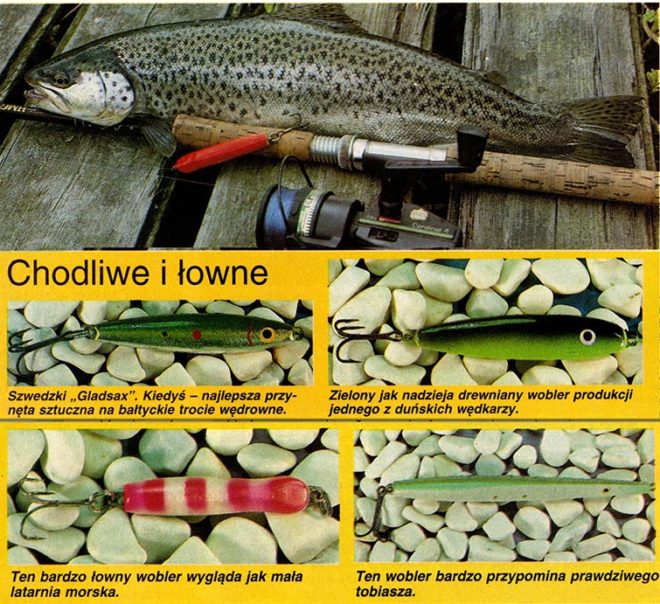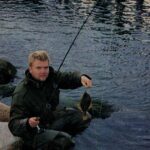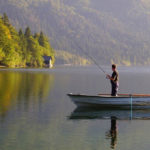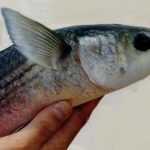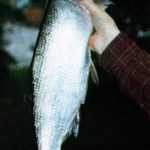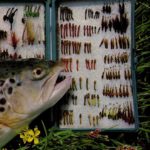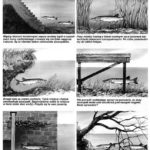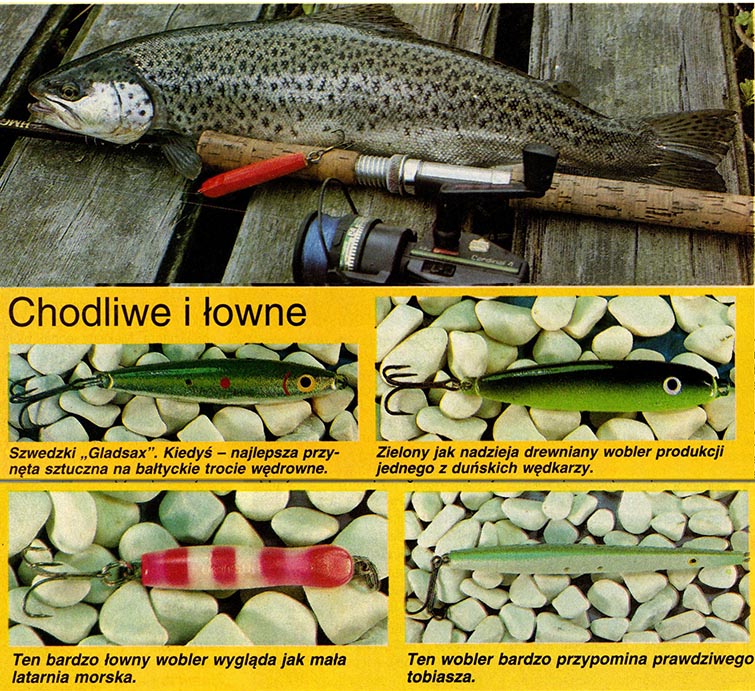 Woblery do łowienia z wybrzeża morskiego nie mają agresywnej akcji. Nawet podczas szybkiego prowadzenia leniwie kolebią się na boki, ale właśnie dzięki temu tak świetnie imitują tobiasze.
Woblery do łowienia z wybrzeża morskiego nie mają agresywnej akcji. Nawet podczas szybkiego prowadzenia leniwie kolebią się na boki, ale właśnie dzięki temu tak świetnie imitują tobiasze.
Uważam, że jest to jedno z piękniejszych doznań wędkarskich – po kilku godzinach łowienia z morskiej plaży nagle czujemy potężne szarpnięcie. Branie jest tak niespodziewane, że o mało nie wyrywa nam kija z ręki. Wcześniej nic nie wskazywało na to, że w łowisku jest choćby jedna troć, a jednak srebrna morska torpeda pojawiła się nie wiadomo skąd i to akurat tam, gdzie nasza błystka samotnie zmierzała do brzegu. Czegoś takiego nie zapomina się do końca życia.
Na pełne piękna łowienie w Bałtyku może sobie pozwolić każdy. W niektórych krajach z wybrzeża morskiego łowi się za darmo, w innych należy wykupić specjalną licencję. Zezwolenie takie jest przeważnie bardzo tanie. Samo wędkarstwo morskie jest natomiast niezwykle proste – wystarczy tylko mieć kij, kołowrotek z żyłką, podbierak, kilka błystek i już można łowić. Jeżeli ktoś nie ma jeszcze w swoim pudełku łownych błystek, powinien najpierw udać się do sklepu wędkarskiego w dowolnej nadmorskiej miejscowości. Po wejściu do środka od razu dostaje się oczopląsu – setki trociowych przynęt, każda winnym kolorze, każda innego kształtu. Słowem wszystko, co rozsądnie myślący człowiek potrafi tylko sobie wyobrazić.
Cudowny wobler
Nie mogąc połapać się w tak olbrzymiej ofercie zwracamy się z prośbą o pomóc do sprzedawcy. Dowiadujemy się, że w morzu najbardziej skuteczne są błystki srebrno – zielone, srebrno – niebieskie, złote, miedziane i zielono – żółte. Kształt i masa przynęty oraz grubość blachy, z której została wykonana decydują o parametrach błystki. Niestety tych właściwości nie jesteśmy w stanie sprawdzić w sklepie. Nad wodą zwracamy przede wszystkim uwagę na zachowanie się przynęty w powietrzu. Próbujmy zawsze tak rzucać, aby błystka leciała w powietrzu jak strzała. Spokojnie szybująca błystka poleci znacznie dalej nawet od cięższej, ale za to fikającej w powietrzu koziołki błystki. Grubość blachy oraz kształt przynęty decydują o opadaniu w wodzie. Wiele modeli wahadłówek wspaniale obraca się na przykład wokół własnej osi opadając przy tym po skosie w dół. Dzięki temu trwa to znacznie dłużej zanim taka przynęta znajdzie się na głębokości, na której zdarzają się już zaczepy.
Bardzo możliwe, że w sklepie wędkarskim sprzedawca doradzi nam, abyśmy kupili, kilka modeli morskich woblerów. O tej przynęcie słyszeliśmy już tyle fascynujących opowieści, że od razu decydujemy się na jej kupno. Nad wodą przeżywamy jednak wielkie rozczarowanie. Żaden z drogich woblerów nie pracuje tak, jak tego oczekiwaliśmy. Trudno tu mówić o jakiekolwiek akcji, skoro przynęta ta leniwie kolebie się na boki i tak na dobrą sprawę to tylko „pomyka” w wodzie na szczytówce kija także nie widać pracy takiego woblera. Nie ma nawet porównania z dobrym szczupakowym woblerem, który przy każdym obrocie korbką wprowadza szczytówkę wędziska w rytmiczne drgania.
Znam wielu wędkarzy, którzy po kilku próbnych rzutach morskim woblerem byli tak rozczarowani, że już nigdy więcej nie dali tej przynęcie szansy, aby mogła udowodnić swą skuteczność. Pierwsze wrażenie jest niestety bardzo mylące. Niezwykle skuteczne woblery do łowienia w morzu wymyślono dość dawno temu, gdzieś na przełomie lat sześćdziesiątych i siedemdziesiątych. Nie wiem kto i gdzie w Danii zaczął jako pierwszy łowić na tę przynętę, wiem natomiast na sto procent, że to właśnie Duńczycy wymyślili woblery do spinningowania z wybrzeża. Oczywiście te pierwsze woblery nie były tak gładkie, piękne i perfekcyjnie wykończone jak dzisiejsze przynęty. Z całą pewnością były jednak tak samo skuteczne.
